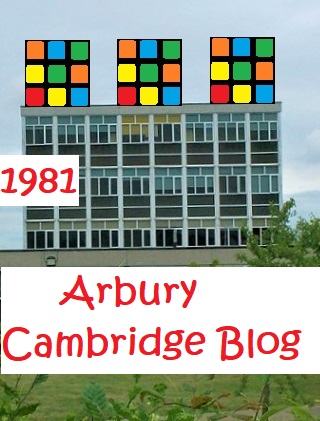I'm adapting the 1986 song Snooker Loopy for the blog post title here, and Rubik's Loopy was certainly very descriptive of the Manor, the forerunner of the North Cambridge Academy, in 1981.
The Rubik's Cube was quite an amazing thing in those days. It penetrated the Iron Curtain and made its way into the Western World - and that was really something!
It was in January/February 1980 that Erno Rubik demonstrated his invention at toy trade fairs in London, Paris, Nuremberg and New York. This was the original 'Buvos Kocka' - 'Magic Cube'. The first test batches of the Magic Cube had been released in its native Hungary just before Christmas 1977, and there had been a small seepage across Hungarian borders in 1978, 1979 and early 1980, including a few into the UK. But the Magic Cube existed in only very small numbers and there were nowhere near enough to break the major pop culture barrier in the UK or the rest of the Western World.
Few people in the UK had even heard of it.
In early 1980, with Ideal Toys, trusted purveyor of many favourite past game and puzzles, now distributing there was great interest in the Magic Cube from the Western World toy industry, but it then had to be remanufactured to Western World safety and packaging standards.
And then Ideal Toys, reasoning that 'Magic' tends to be associated with magic, decided to rename it. Would it be 'The Gordian Knot' or 'Inca Gold', perhaps? They finally chose 'Rubik's Cube'. The Rubik's Cube was lighter and easier to manipulate than the Magic Cube - laying the way open to speed-cubing contests. The first batches left Hungary in May 1980. The trademark was registered in the UK on 7 May 1980.
A Rubik's Cube in its original packaging.Well, that was all very well, but as production had only just started on the new Cube, and the old Cube had never existed in great numbers, there was a worldwide shortage. 1980 was mainly cube-less in the UK, a few arriving just before Christmas. Noting the tremendous interest, the British Association of Toy Retailers named it 'Toy of the Year 1980' and, as stocks arrived in the spring of 1981 and the craze took wing, it won the 1981 title too.
And the Cube was heading here, there, everywhere. And it was heading for Arbury.
The Rubik's Cube took over Arbury and the world in 1981.The unofficial Rubik's Cube Contest between the Manor and Chesterton schools in July 1981 ended in victory for Chesterton. The Manor champion was away on the day of the contest and a substitute had to be sent. I wonder if the champ had succumbed to nerves? Upholding the Rubik's honour of a school was a very serious business then. The trouble was, the Cube looked so simple - an attractive children's toy, something from a nursery play-box. Surely, we could do it? Ours sat on the sofa at home, beguiling us into having just one more go. But simple it was not!





Comments
Post a Comment